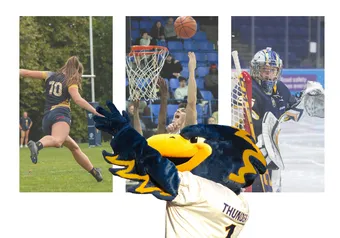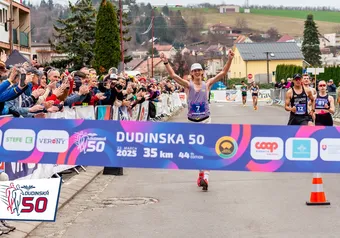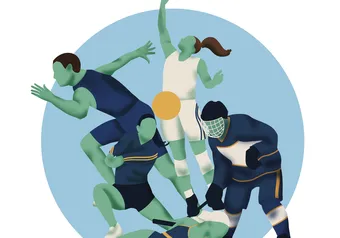Jesse Symons is passionate about coaching. You can tell in the way he talks about his team. The UBC women’s soccer coach speaks with a quick pace like a forward chasing down a ball, dives into details like a fearless defender into a tackle and his excitement grows when talking about his players as if his team was on the counterattack.
His team was fresh off their national championship run and the team looked poised to repeat with most players returning.
The program had done it before. In 2003 the T-Birds won nationals for the second straight year after being crowned champions in 2002. The program would go on to win another national championship in 2006, making it three banners in a five-year span, and their seventh national championship in 2019 gave UBC women’s soccer the most national championships in U Sports history.
“Just to match that level of standard and expectation is important,” Symons says, referring to the teams from the 2000s. “But we also haven’t won a Canada West championship now in three seasons so that’s another thing that is definitely motivating for the team.”
“We did win [nationals], but we also weren’t as successful in every aspect of the season-there’s a lot more motivation still to go.”
About to enter his fifth season, Symons knew that winning nationals was/would be difficult and winning it two straight years would be even harder. His team would have to play more consistently and play with more intensity since other teams would be motivated to knock off the defending champions.
“It’s been interesting hearing from older players after winning [nationals] and getting to that level,” he told me. “They sort of experienced both sides of it now and know how difficult it is to get to those stages.”
“They’re really pushing even now in preparations for, hopefully, this upcoming year.”
By the time of the interview, with universities switching to web-oriented courses and travel restrictions being imposed, it was likely that fall sports, such as soccer, were going to be put on hold. Less than a month after we spoke, the 2020 season was cancelled.
Throughout that time, more interviews that he did?? with players from the 2019 team were starting to make it clear why women’s soccer were able to win nationals after a disappointing 2018 season.
The 2018 season had ended with UBC losing in the Canada West consolation final. It was the second time in as many seasons that the T-Birds did not qualify for nationals and the second straight year the team did not advance to the Canada West final. As a program with six national championships, losing in this way was questionable.
Was it inexperience and nerves? Was there issues within the team? Was there a lack of will to win?
Since Symons took over as head coach, the performance of the team had wavered. His first season, he coached the T-Birds to a Canada West title and finished second at nationals. But his second and third years were less successful and the program appeared on the decline.
Their rivals were improving. After beating the Trinity Western University Spartans in the Canada West title game his first season, Symons had lost to the Spartans in the Canada West semi-final, his second season, and did not beat the Spartans in his third. His third season also included losing in the Canada West semi-final to the University of Calgary Dinos, a team that had beaten UBC twice that year and a program that was on the rise.
Talent was not an issue. The T-Birds were recruiting and featuring some of the best scorers over the past couple seasons, including former U Sports women’s soccer player of the year Jasmin Dhanda, despite the team failing to reach their goals.
As his team prepared for 2019, Symons realized changes were needed and reached out to fifth-year player Amelia Crawford during the offseason.
Before coming to UBC, Crawford had played for Fusion FC in the BC Soccer Premier League. The Richmond native was in her last year of high school when a former UBC assistant coach saw her play.
“After one of our games, I remember one of the UBC coaches at the time, Mark Eckerle, came up to me after the game and was like ‘Oh are you Amelia Crawford?’ and gave me the whole speech,” she told me over the phone.
She then went on a campus tour and was offered a spot on the team. Crawford signed on and her first year with the T-Birds could not have been better. After an early season loss, the team went on a 17 game unbeaten streak where they finished atop the conference in the regular season, won the Canada West title game and ended the year by winning nationals.
“In first year, it was really exciting because we hosted nationals so we had a huge crowd for every game,” she recalls. “I feel that because I was in my first year I was a bit naive about what was even happening. I was like ‘Oh this is what happens with this program,’ like ‘Oh this is what university soccer is.’”
Her second season started with Symons replacing Marisa Kovacs as head coach. Despite the coaching change, the team managed to win the Canada West title again and earn another berth at nationals-reaffirming Crawford’s beliefs about the program.
“I was like ‘Oh again UBC,’” she says with a laugh.
Crawford admits that her third and fourth year made her realize how difficult it was to qualify for nationals, as the team failed to advance past the Canada West final four.
Entering 2019, her final year at UBC, Crawford was now the last player remaining from the 2015 championship team.
It was expected that the team would carry three fifth-year players in 2019 since there were other fourth-year players on the 2018 team but Crawford was the only fourth-year who returned as eight players from the 2018 team, who were eligible to return, left early.
When asked why players were left early, one UBC player which player told me that the players “weren’t as committed to doing a full student-athlete load.”
“They were interested in other things rather than soccer and school,” she told me. “In the end it was maybe better for the team [to have] people being fully committed and [who] wanted to be there.”
“And that’s nothing against them at all, it’s just if you want to be there then be there.”
Between graduation and players leaving early, a total of ten players left the program following the 2018 season. While the team carried 27 players in 2018, the roster for 2019 was down to 24 with a third of the players having not played a game for the T-Birds.
“It was a bit tricky [because] we had a lot of turnover with the program,” Crawford said.
“I think initially everyone was kind of concerned about that because [there] was a lot of open positions that were kind of left after that happened.”
With players leaving and positions left open in the lineup, Symons was searching for players able to fill those roles.
“There [were] definitely a couple questions in terms of our starting eleven, “ Symons said. “We [were] wrestling a bit with fullbacks and who to play in those sort of positions-one could do the defensive job and also go forward when needed.”
He asked Crawford about switching to fullback.
“He actually called me before [the] preseason started, I think it was July,” Crawford recalls. “He’s like ‘How do you feel about playing defense?’”
Crawford thought Symons was joking at first. Throughout her time at UBC, she played mostly forward and not fullback. Later Crawford realized that her responsibilities in her new position were similar to her responsibilities as forward.
Symons described that this fullback position required a player who “could do the defensive job and also go forward when needed” while playing in the 4-4-2 diamond formation.
A quick Google search, or an afternoon playing FIFA, will show that the 4-4-2 diamond formation contains two strikers, or centre forwards, up front with two fullbacks and two centre-backs that form the backline.
The formation gets its name from the middle. Instead of the four midfielders forming a horizontal line, the midfielders form a diamond shape. At the top of the diamond there is an attacking midfielder and at the bottom there is a holding midfielder. The sides of the diamond are formed by wingers who play below the attacking midfielder and above the holding midfielder.
The formation is generally viewed as one suited for athletic teams that are attacking minded. For example, what makes the diamond formation threatening is that it capitalizes on athletic fullbacks who can go up and join the attack. When this happens, the 4-4-2 diamond turns into a 3-5-2 with the fullback playing alongside the midfielders, if only on the attack, and can confuse opponents.
The key to the formation is its reliance on communication and coordination. For instance, often midfielders will rotate throughout a game and miscommunication between these players, or other players rotating, can lead to quality scoring chances for the opposing team.
The nuances of the 4-4-2 diamond might explain why most teams in the Canada West use the basic 4-3-3 formation. While the 4-3-3 formation is relatively straightforward in its shape, the diamond requires learning the role of different positions and Crawford admitted that the diamond can “be a bit frustrating” if you don’t know where to be or get lost in the diamond.
“If one person doesn’t press or go to a position they are supposed to be in at certain times then the whole thing can break down,” she explains. “Or if someone steps too soon-when they are not supposed to then it can affect the whole system defensively.”
As a fullback, Crawford was responsible for preventing such lapses. She told me that the formation was introduced in past years, which allowed her to adjust to her new position while her younger teammates adjusted to playing in the 4-4-2 formation. this ends a bit abruptly?? could you maybe add in something to make it feel more like the end of the piece, even if it is the first part
my only big note is that this is very very long. i think you might lose some readers half way through! maybe go through and see what can be cut
Share this article
First online


![['auto']](https://storage.googleapis.com/ubyssey/media/renditions/image_from_ios_2.width-1000.format-webp_2ETKSCE.webp)


